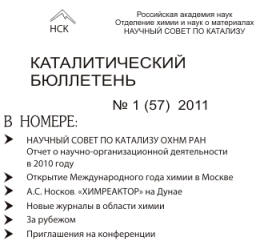
НАУЧНЫЙ СОВЕТ ПО КАТАЛИЗУ ОХНМ РАН
Отчет о научно-организационной деятельности в 2010 году
Под эгидой Научного совета по катализу ОХНМ РАН (НСК) и при активном участии его членов в 2010 году были проведены следующие конференции:
Выпущено 4 ежеквартальных сборника «Каталитический бюллетень», содержащих информацию о результатах фундаментальных и прикладных исследований в области катализа в России и за рубежом, о памятных датах и юбилейных мероприятиях. Изданы материалы проведенных конференций. Ведется переписка и текущая работа с членами Научного совета по катализу ОХНМ РАН. Продолжается сотрудничество с организациями Академий наук РФ и стран СНГ, Министерствами РФ, институтами разных ведомств и другими организациями России, дальнего и ближнего зарубежья по различным вопросам научной, научно-организационной, учебно-преподавательской и общественной деятельности в области катализа.
Ниже представлены основные результаты исследований в области катализа, полученные в 2010 г. научно-исследовательскими коллективами, возглавляемыми членами НСК. Отчеты расположены по организациям в алфавитном порядке.
Разработана технологическая документация на производство углеродных наноразмерных продуктов (УНП), а также катализаторов для их получения. Выпущены регламенты на процесс синтеза никельсодержащих катализаторов и на технологию получения четырех базовых типов углеродных продуктов (УНП). Определены условия получения УНП с максимальной селективностью по заданному морфологическому типу (80-90%).
Разработана технологическая документация (регламенты) на производство УНП с коаксильно-цилиндрической морфологией и кристаллографией, а также катализаторов на основе Co-Mo-Fe-Al.
Технология производства углеродных наноразмерных продуктов (УНП) создана на основе нового типа вращающегося горизонтального реактора с движущимся слоем катализатора.
Созданные пилотные установки позволяют получить до 200 кг продукта в год и являются рабочим прототипом для проектирования более производительных установок.
чл.-корр. РАН Р.А. Буянов
Анион-радикалы кислорода О– играют важную роль в различных физико-химических процессах, включая процессы на поверхности твердых тел, где их поведение особенно трудно поддается изучению. В данной работе в широкой области температур (198-513 К) впервые детально изучена роль радикалов О–, адсорбированных на поверхности цеолита FeZSM-5, в реакции изотопного обмена О2. Благодаря большой концентрации О– (в данной системе они называются α-кислородом, О α), которая на несколько порядков превышает их концентрацию на других системах, удалось надежно установить два механизма обмена, Ro и R1, протекающих в присутствии Оα).
Механизм R1 (E = 3,5 ккал/моль) доминирует в области повышенных температур и, аналогично обмену О2 на V2O5/SiO2 (Казанский и соавт.), может быть представлен в виде следующего уравнения:

Обмен Ro (E = 0,2 ккал/моль) представляет собой новый канал реакции, который в присутствии α-кислорода открывается в области криогенных температур и приводит к перераспределению изотопов только между молекулами О2 газовой фазы, не затрагивая изотопный состав Оα. Механизм этого обмена менее ясен. Необходимость присутствия Оα без его непосредственного участия в обмене кажется весьма удивительной. Реакция может протекать через гипотетический комплекс [O-5]α , в котором происходит перераспределение связей между двумя молекулами О2. Разрыв и перераспределение столь прочных связей при криогенных температурах с почти нулевой энергией активации представляет собой необычное явление, которое заслуживает дальнейшего изучения.
М.В. Парфенов, к.х.н. Е.В. Староконь, к.х.н. С.В. Семиколенов, д.х.н. Г.И. Панов
Кинетика и механизм реакции разложения закиси азота:
N2O → N2 + ½ O2 (1)
были детально исследованы на серии образцов FeZSM-5 с широкой вариацией концентрации α-центров (FeII)α. Результаты сопоставлены с реакцией окисления бензола в фенол закисью азота, которая раньше была изучена на этой же серии образцов:
N2O + С6Н6 → N2 + С6Н5ОН (2)
Несмотря на большие различия в частоте оборотов (~ два порядка) и в энергиях активации (~ 20 ккал/моль), эти реакции имеют родственный механизм. Скорость каждой из них линейно возрастает с повышением концентрации α-центров.
Каждая реакция включает две основных стадии. Первая стадия является общей и представляет собой окисление α-центра с посадкой α-кислорода:
(FeII)α + N2O → (FeIII–O–)α + N2 (3)
На второй стадии происходит восстановление α-центра за счет удаления α-кислорода благодаря его взаимодействию либо с молекулой N2O, либо с молекулой бензола. В обоих случаях эта стадия является лимитирующей.
С точки зрения механизма, окисление бензола в фенол можно рассматривать как реакцию восстановления N2O бензолом. Учитывая, что цеолиты FeZSM-5 являются эффективными катализаторами восстановления закиси азота с помощью различных углеводородов (метан, этан, пропан и т.д.), можно полагать, что и в этих случаях α-центры также играют ключевую роль.
к.х.н. Л.В. Пирютко, В.С. Чернявский, к.х.н. Е.В. Староконь,
к.х.н. А.А. Иванов, д.х.н. А.С. Харитонов,
С использованием нового метода синтезированы труднодоступные практически важные 14-спироциклопропилгексацикло[6.5.1.02,7.03,12.06,10.09,13]тетрадец-4-ен, 6-спироциклопропилпентацикло[7.5.0.02,7.03,5.04,8]тетрадека-10,12-диен, изомерные (Z/E) эндо-бицикло[4.2.1]нона-2,4-диены и трицикло[9.4.1.102,10] гексадека-2(3),12,14-триен с высокими выходами, > 80%. С применением современных спектральных методов (ЯМР 13С, 1Н, масс-спектрометрии высокого разрешения) и РСА установлена структура и конформация синтезированных соединений и показана перспективность применения полученных новых классов полициклических соединений для синтеза противовирусных препаратов.
Сканированием поверхности потенциальной энергии системы Cp2ZrCl2 c HАlBui2 квантово-химическими методами DFT в приближении РВЕ/3z предложен механизм образования ключевого мостикового комплекса Cp2ZrCl2°HАlBui2 и продукта его диссоциации до гидрохлорида цирконоцена Cp2ZrHCl (реагента Шварца). При последующем взаимодействии реагента Шварца с исходной молекулой HАlBui2 последовательно образуются молекулярные комплексы Cp2ZrH2•ClAlBui2 и Cp2ZrH2•HAlBui2•ClAlBui2, которые гидроцирконируют алкены. На завершающейся стадии происходит переметаллирование алкильных производных циркония, образующихся в результате гидроцирконирования алкенов с помощью исходных алюминийорганических соединений, что приводит к получению высших алюминийорганических соединений и регенерации каталитически активных центров.
В их числе – получение этилбензола в шестислойном адиабатическом реакторе с раздельной подачей бензола и этилена на каждый слой и двумя различными температурами, а именно, на входе в первый слой и на входе в последующие пять слоев, а также при получении стирола в каскаде из двух адиабатических реакторов с промежуточным подогревом реакционной смеси после первого реактора. Разработанные оптимальные режимы позволяют в зависимости от скорости подачи сырья увеличить выход этилбензола на 5-7%.
Способ основан на использовании доступного сырья (гомогенные смеси олигоэтоксисилоксанов и спиртовые растворы солей алюминия) и включает такие последовательные стадии как гомогенизация исходных компонентов, их гидролиз при 60-100°C и атмосферном давлении, выделение образующегося осадка и его термообработка при 550-650°C. Полученные алюмосиликаты обладают высокой каталитической активностью в реакциях олигомеризации и гидратации C6-C8 - α-олефинов.
Предложенный способ основан на термохимической обработке при 540-600°C в среде водяного пара ранее синтезированного нами кристаллического алюмосиликата, гранулы которого представляют единые сростки кристаллов цеолита типа FAU. Полученные материалы обладают высокой степенью кристалличности и соотношением Si/Al = 7,0-35,0 и перспективны в качестве катализаторов реакций (алкилирование бензола этиленом, диспропорционирование диэтилбензолов и бензолов в этилбензол, олигомеризация α-октена).
член-корр. РАН У.М. Джемилев
академик С.Н. Хаджиев, д.х.н. И.И. Иванова (МГУ им. М.В. Ломоносова)
академик С.Н. Хаджиев, ст.н.с. И.М. Герзелиев
академик С.Н. Хаджиев, к.т.н. Х.М. Кадиев
академик С.Н. Хаджиев, к.т.н. Х.М. Кадиев
академик С.Н. Хаджиев, д.х.н. Н. В. Колесниченко
академик С.Н. Хаджиев, д.х.н. А.Ю. Крылова
академик С.Н. Хаджиев, д.х.н. М.В. Цодиков
Обнаружено, что при совместном окислении карбоновых кислот и СО в присутствии родиевого катализатора происходит окислительное декарбонилирование уксусной и пропионовой кислот до метанола (метилацетата) и этанола (этилпропионата) соответственно. Обнаружено также необычное явление — замещение атома водорода на дейтерий в алкильной части молекул продуктов окислительного декарбонилирования пропионовой кислоты при окислении в протонодонорных дейтерированных растворителях. Показано, что пропионовая кислота, метильная группа которой отдалена от электроноакцепторной карбоксильной, ведет себя подобно насыщенному углеводороду.
чл.- корр. РАН М.Е. Гехман
Изучение каталитической активности биметаллических порошков палладия с цинком, кобальтом и никелем в реакциях разложения гидразина и восстановления урана(VI) гидразином и муравьиной кислотой показало, что природа переходного металла оказывает существенное влияние на каталитическую активность палладия в исследованных биметаллических наночастицах. Каталитическая активность наночастиц Pd-Ni существенно превосходит активность более мелких частиц палладия в составе гетерогенного катализатора, имеющего более развитую поверхность. В то же время наночастицы Pd-Co, Pd-Zn и Pd-Ag не катализируют изученные реакции.
чл.- корр. РАН М.Е. Гехман
Разработан отечественный способ получения 7,8-дифтор-2,3-дигидро-3-метил-4Н-1,4-бензоксазина, ключевого интермедиата в синтезе антибиотика левофлоксацина, предназначенного для лечения широкого спектра инфекционных заболеваний человека.
Способ заключается в восстановлении 2-ацетонилокси-3,4-дифторнитробензола в спиртовой среде путем каталитического гидрирования в присутствии палладия на углеродном носителе «Сибунит» в качестве катализатора, давлении водорода 3.0-3.5 бар и температуре 30-50°C. Проведение синтеза в данных условиях позволяет снизить образование побочных продуктов дефторирования до 0.1-0.15% в реакционной массе.
академик В.Н. Чарушин, академик О.Н. Чупахин, к.х.н. Г.Л. Русинов и др.
Перспективным способом обезвреживания полихлорбифенилов (ПХБ) - стойких органических загрязнителей - является метод их восстановительного дехлорирования (гидродехлорирования), в результате которого происходит перевод ценного органического сырья (ПХБ) в малотоксичные (нетоксичные) продукты, которые могут быть использованы как практически полезные материалы. Развитие методов восстановительного дехлорирования связано с возможностью использования новых типов катализаторов на основе металл-углеродных композиций, как, например, М/Сибунит (М = Ni, Pt, Pd).
Установлено, что наиболее активными являются катализаторы на основе Pd/Сибунит с содержанием палладия 5%. Использование такого катализатора позволяет достичь конверсии 95% при проведении гидродехлорирования в жидкой фазе в присутствии щелочи, при комнатной температуре и давлении водорода 1 атм. Изменение условий процесса позволяет регулировать его региоселективность.
академик Чупахин О.Н., д.х.н., проф. Салоутин В.И. и др.
Проведено исследование влияния режима перемешивания на процесс получения комплекса хлорида неодима с изопропиловым спиртом для стереоспецифической полимеризации изопрена. Моделирование заводских условий синтеза этого комплекса (перемешивание в объемном аппарате мешалкой рамочного типа) показало, что достаточное количество комплекса образуется через 3-4 часа непрерывного перемешивания. При этом процесс сопровождается снижением радиуса частиц исходного хлорида неодима. Гидродинамическое воздействие в трубчатом турбулентном реакторе диффузор-конфузорной конструкции в момент смешения хлорида неодима с изопропиловым спиртом приводит к значительному ускорению процесса (в 5-7 раз) и формированию нано-размерного комплекса (50-63 нм, вместо 100-200 нм). Разработанная инновационная энерго- и ресурсосберегающая технология может быть использована в производстве каучука марки СКИ-5 со сниженной себестоимостью.
академик Ю.Б. Монаков, д.х.н., проф. В.П. Захаров
Разработаны новые высокоэффективные инициирующие/каталитические системы на основе клатрохелатов кобальта(II), пивалатных комплексов Fe(III), Mn(II), Cu(II) и Со(II) для радикальной полимеризации виниловых мономеров, позволяющие получать полимеры с широким диапазоном молекулярных масс.
Получен патент на изобретение № 2394045 и положительное решение о выдаче патента на изобретение от 01.10.2010 по заявке № 2009117583/20(024159), согласно которым предложены способы получения полиметилметакрилата в присутствии клатрохелатов Fe(II) и азиниловых производных ферроцена, соответственно. Изобретения позволяют проводить полимеризацию метилметакрилата с высокой скоростью при температурах 30-60°C, снизить расход компонентов инициирующей системы, устранить нежелательный гель-эффект, регулировать молекулярную массу получаемого полимера, повысить стереорегулярность и термостойкость получаемого полимера.
академик Ю.Б. Монаков, д.х.н., с.н.с. Р.М. Исламова
Проведено модифицирование оксида алюминия посредством синтеза на его поверхности смешанного алюмомагниевого оксида. В качестве предшественника данного смешанного оксида был использован слоистый алюмомагниевый гидроксид типа гидротальцита. Его синтез заключался во взаимодействии гидроксидов магния и алюминия в поровом пространстве носителя γ-Al2O3. Новизна состоит в том, что в синтезе принимала участие бемитная фаза AlO(OH), образующаяся непосредственно на поверхности носителя γ-Al2O3 в гидротермальных условиях. Данный подход обеспечивал “привязку” формирующейся фазы к поверхности исходного носителя при сохранении его текстурных параметров. Исследование закрепления H2PtCl6 на модифицированном носителе показало, что адсорбированные на поверхности платиновые формы представляют собой обогащенные хлором комплексы даже при низком содержании металла.
Каталитические свойства полученных нанесенных катализаторов исследованы в реакции дегидрирования пропана в сравнении с традиционным алюмоплатиновым катализатором и образцами, приготовленными с использованием массивных алюмомагниевых гидроксидов. Показано, что при близком выходе пропилена образец, полученный с использованием нанесенного алюмомагниевого оксида, характеризуется большей стабильностью в результате малого вклада реакций образования высокомолекулярных продуктов реакции.
чл.-корр. РАН В.А. Лихолобов., к.х.н. О.Б. Бельская
Сегодня актуальна разработка новых типов катализаторов или специальных добавок, переводящих в процессе крекинга сероорганические соединения сырья либо в газовую фазу в виде сероводорода, либо в более тяжелую дизельную фракцию. В данной работе изучено влияние кислотных и основных активных центров добавок к катализатору на остаточное содержание серы в жидких продуктах крекинга. Оценено влияние реакций ароматизации и переноса водорода как основного направления реакций деароматизации тиофена.
Исследовано три группы добавок: 1) льюисовский кислотный компонент (оксиды Zn, Zr, Ce, Cr, Cu) на оксиде кремния (оксид кремния каталитически не активен в условиях крекинга); 2) основный компонент (оксиды Ca, Mg, Al) на оксиде кремния; 3) кислотный компонент на носителе с основными свойствами - оксид цинка на смешанных Mg, Al-оксидах, полученных из гидротальцитов с различным соотношением Mg : Al.
Показано, что увеличение кислотности добавки при крекинге модельной системы н-ундекан–бензотиофен приводит к существенному уменьшению относительного содержания серы в жидких продуктах. Это подтверждает необходимость присутствия высокой концентрации льюисовских кислотных центров для реализации механизма крекинга тиофеновых структур до сероводорода. В то же время наличие льюисовских кислотных центров способствует протеканию реакций переноса водорода и приводит к увеличению выхода производных гидротиофена, являющихся циклическими сульфидами. Такие неароматические соединения серы в условиях каталитического крекинга превращаются в сероводород и соответствующий олефин.
Наличие только основных центров в составе добавки при крекинге н-ундекана с бензотиофеном не способствует снижению содержания серы в жидких продуктах, а, напротив, увеличивает его за счет иного перераспределения серы в получаемых продуктах.
Полученные результаты при крекинге углеводородного сырья, содержащего 2-метилтиофен и бензотиофен, на добавках III-й группы подтверждают необходимость одновременного присутствия кислотных и основных центров для превращения сераорганических соединений в условиях крекинга. При разработке добавок к катализатору крекинга для снижения содержания серы в бензиновой фракции следует учитывать не только влияние кислотно-основных свойств добавки, но и влияние ее ароматизирующей функции, способствующей протеканию реакций переноса водорода. Результатом совместного протекания реакций переноса водорода и ароматизации является образование гидропроизводных тиофена, легко крекируемых до сероводорода в условиях каталитического крекинга.
к.т.н. В.П. Доронин
Идея процесса одностадийного синтеза пропилена из этилена заключается в осуществлении на одном катализаторе трех последовательных реакций — димеризации этилена, изомеризации образующегося бутена-1 в бутены-2 и последующего образования пропилена по реакции метатезиса этилена и бутенов-2. Был проведен расчет равновесных составов смеси этилен-пропилен-бутены в интервале температур 100-700°C методом минимизации энергии Гиббса, который показал, что в низкотемпературной области в системе преобладают реакции димеризации этилена, которые можно считать необратимыми вплоть до 200°C. Равновесное содержание пропилена при этом не превышает 5-7 мас.%. Определение возможных показателей каталитического процесса синтеза пропилена в низкотемпературной области было осуществлено методом кинетического моделирования. Математическая модель процесса была построена исходя из предположения, что все стадии процесса кроме димеризации этилена являются термодинамически контролируемыми. В результате установлено, что при температурах 40-120°C степень превращения этилена, оптимальная для достижения наибольшего выхода пропилена (58%), должна составлять около 80%.
Эксперименты по изучению кинетических закономерностей процесса одностадийного получения этилена из пропилена на катализаторе NiO-Re2O7/B2O3-Al2O3 подтвердили адекватность предложенной модели и позволяют определить наиболее перспективный путь совершенствования катализатора, состоящий в необходимости увеличения его активности и селективности в первичной реакции димеризации этилена.
чл.-корр. РАН В.А. Лихолобов., к.х.н. А.В. Лавренов, Е.А. Булучевский
Проведена оптимизация условий процесса гидродеоксигенации растительного масла на катализаторе Pt/B2O3-Al2O3 с точки зрения выхода дизельной углеводородной фракции, ее компонентного состава (отсутствие алкеновых и ароматических углеводородов, присутствие изоалканов) и стабильности его действия. В качестве оптимальных выбраны условия, соответствующие температуре 400°C, массовой скорости подачи сырья 1.0 ч–1, давлению 40 атм. При данных условиях обеспечивается стабильная работа катализатора в течение не менее 20 часов и получение компонента дизельного топлива с выходом 69.4 масс.%, состоящего только из алканов С12-С18 (доля изоалканов до 83 масс.%). Предложена общая схема превращений, которые могут протекать при гидродеоксигенации растительного масла на катализаторе Pt/B2O3-Al2O3 в различных условиях и с учетом как совместного, так и раздельного действия его активных центров — металлических и кислотных.
Установлено, что дезактивация катализатора связана с ослаблением действия его кислотных центров, определяющих протекание гидродеоксигенации по направлению гидрирования/дегидратации. Причиной ослабления кислотной функции катализатора может являться блокировка кислотных центров полиеновыми и алкилциклопентадиеновыми соединениями, образующимися в результате реакций сопряженной олигомеризации промежуточно образующихся алкенов.
к.х.н. А.В. Лавренов, Ю.А. Чумаченко
В 2010 году на катализаторном производстве ОАО “Газпромнефть-ОНПЗ” выпущено около 600 тонн нового бицеолитного катализатора крекинга “Люкс марки А”, который предназначен для повышения октанового числа бензина и увеличения отбора легких олефинов как сырья для процессов алкилирования и производства МТБЭ. Катализатор начал загружаться на установку крекинга комплекса КТ-1/1 ОАО “Газпромнефть-ОНПЗ” мощностью 2 млн. тонн в год с марта 2010 года.
В результате замены около 80% катализатора предыдущей версии на бицеолитный при сохранении высокого отбора бензина крекинга:
Руководством ОАО “Газпромнефть-ОНПЗ” принято решение эксплуатировать установку крекинга в 2011 году на новом бицеолитном катализаторе “Люкс А”. Будет выпущено около 750 тонн нового катализатора.
к.т.н. В.П. Доронин
Разработана технология производства новой версии экструдированного катализатора риформинга ПР-81 применительно к условиям производства ОАО Ангарский завод катализаторов и органического синтеза (г. Ангарск, НК “Роснефть”). Регламент на производство и Технические условия на катализатор согласованы и утверждены производителем. Наработана первая промышленная партия катализатора ПР-81 в количестве 2 тонны. Катализатор загружен на установку ЛП-35-11/40 ООО “Пурнефтепереработка” НК “Роснефть” в июне 2010 г.
Новая марка катализатора ПР-81 выгодно отличается существенно меньшей температурой достижения октанового числа риформата 95 (ИМ) ─ 467 против 487°C, что свидетельствует о его значительно большей активности. Основной особенностью селективности действия нового катализатора является снижение содержания ароматических углеводородов при равной величине октанового числа. Уменьшение ароматических углеводородов (на 7-8 % мас.) достигается за счет существенно меньшего содержания низкооктановых С8-С10 парафинов и повышенного содержания парафинов С4-С5. Мягкий температурный режим процесса обеспечивает высокую стабильность работы катализатора. Скорость подъема температуры для компенсации потери активности катализатора составила 2°C за 6 месяцев работы.
д.х.н. А.С. Белый
На базе исследований кинетики и механизма каталитического гидрирования тринитротолуола показана возможность получения не только продукта исчерпывающего гидрирования - триаминотолуола, но и ряда ценных промежуточных соединений, перспективных для последующих синтезов материалов гражданского применения. Предложены активные и селективные катализаторы парциального гидрирования, реализующие различные направления протекания процесса с высокими выходами промежуточных продуктов. С использованием катализатора 4%Pd/Al2O3 с выходом более 90% получена смесь 2-амино-4,6-динитротолуола и 4-амино-2,6-динитротолуола — перспективных реагентов для различных органических синтезов и фармацевтических субстанций; в присутствии 5% Pd/C — с выходом более 98% смесь мононитродиаминосоединений — полупродуктов для синтеза красителей нового поколения; в присутствии 0,2% Pd/стекловолокно — 2,6-динитро-4-толилгидроксиламин — высокореакционноспособный реагент для органического синтеза. Указанные продукты ранее получались исключительно многостадийными стехиометрическими методами.
Катализ комплексными соединениями металлов приобрел исключительное значение в синтезе сложных органических молекул. Об этом свидетельствует Нобелевская премия по химии 2010 года (третья премия в этой области за последнее десятилетие). В последнее время нанокатализ становится важной частью нанонауки (nanoscience), и это касается не только металлокомплексного катализа, но и катализа органического. Если рассматривать такой катализ как мост между гомогенным и гетерогенным катализом, то в таком случае следует ответить на вопрос, что на самом деле является активной формой катализатора. Нам удалось на примере классической реакции Сузуки (Suzuki) (который получил Нобелевскую премию по химии этого года) осуществить реакцию арилгалогенида с арилборной кислотой, катализируемую наночастицами палладия (НЧП), нанесенными на растворимый в воде триблоксополимер Плюроник в исключительно мягких условиях — при комнатной температуре, и показать, что не только размер НЧП, но и их структура, морфология ответственны за эффективность каталитической системы.
Путем вакуумного напыления палладия на подложку из поливинилового спирта с дальнейшим растворением подложки в горячей воде получены НЧП в отсутствие какой-либо подложки. Образующийся палладий является аморфным и состоит из легко различимых частиц металла наноразмера (~ 10 нм). Обнаружено, что такие довольно крупные НЧП окисляются кислородом с образованием Pd(II), который восстанавливается в условиях реакции в Pd(0) в виде НЧП меньшего размера. Полученные в работе результаты предполагают возможность легкого образования активных частиц палладиевого катализатора из неактивных агрегированных частиц за счет окисления кислородом воздуха. Дальнейшее восстановление образующихся соединений палладия(II) приводит к получению активного катализатора.
В продолжение наших работ по использованию регенерируемого катализа органическими молекулами в синтезе мы провели реакцию присоединения карбанионов (СН-кислоты в присутствии основания) к активированным олефинам — присоединение по Михаэлю, используя в качестве катализатора-основания сополимер поливинилимидазола с поливинилкапролактамом. Естественно, что в случае органического катализа не существует проблемы вымывания (leaching) и потери активности катализатора (если только он не взаимодействует с образующимися продуктами), и его можно использовать многократно (в идеале бесконечно).
Совершенно очевидно, что особый интерес представляет многократное использование дорогих хиральных органических катализаторов.
Используя пришитое на ионную жидкость производное пролина, были синтезированы оба изомера
В другой изученной нами реакции Пудовика между имином бензальдегида и диэтилфосфитом при катализе двумя формами по-разному пришитого на полиэтиленгликоль хирального катализатора BINOL-фосфата нам удалось показать, что структура подложки существенно влияет на свойства катализатора и на скорость и селективность катализируемых реакций.
Руководитель работ академик РАН И.П. Белецкая
Одностадийный синтез ароматических углеводородов из газообразных алканов на цеолитсодержащем катализаторе характеризуется сложными кинетическими закономерностями, и поэтому изучение его кинетики следует проводить с привлечением метода математического моделирования, используя экспериментально полученные данные по влиянию различных факторов на выход и состав продуктов. Варьированием расхода сырья при сохранении одинакового времени контакта установлены области протекания процесса превращения природного газа: при расходе сырья от 8,3 до 25,0 мл/мин процесс протекает во внешнедиффузионной области, увеличение расхода сырья более 25,0 мл/мин позволяет перевести процесс в кинетическую область. Результаты кинетических исследований представлены в виде кинетических кривых превращения природного газа в ароматические углеводороды на катализаторе 0,5% Ga-4,0% Mo/ZSM-5/10% Al2O3, полученных при временах контакта 0,72-3,6 с и температурах 600-750°C (рисунок 1). Для компонентов природного газа составлены возможные реакции их превращения на данном катализаторе и с привлечением справочных данных рассчитано изменение термодинамических функций в ходе этих реакций. Определены скорости образования и расходования компонентов при протекании процесса. На основе полученных данных установлены наиболее вероятные маршруты превращений компонентов реакционной смеси и кинетические закономерности процесса, что дает возможность для проведения моделирования его кинетики и расчета основных параметров реакторного узла.
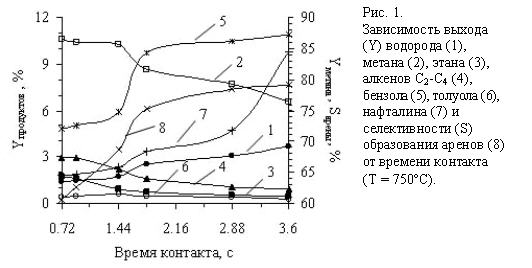
Д.х.н. А.В. Восмериков
Для повышения каталитической активности ферросфер системы CaO - Fe2O3 с содержанием Fe2O3
Активность модифицированных оксифторидных систем на основе ферросфер увеличивается в три раза. При этом начальная селективность образования С2-продуктов снижается до 64-68%, а величина отношения С2Н6/С2Н4 до
Изменение каталитических свойств фторированных систем на начальном участке можно объяснить формированием новой каталитически активной оксифторидной компоненты, отвечающей за последовательное превращение С2Н6 в С2Н4 и СО2 (рис.). Под действием реакционной среды (в первую очередь паров воды) происходит разложение (60 мин) оксифторидных комплексов железа и кальция, что сказывается на резком снижении SС2Н4 и увеличении SСО2. При этом SС2Н6 во всем диапазоне изменяется незначительно, что свидетельствует о наличии независимых центров его образования, характерных для исходных ферросфер.
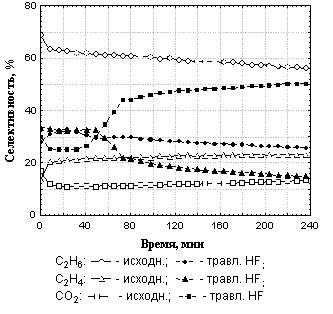 Рис. Зависимость селективности от времени воздействия реакционной среды на образцах
Рис. Зависимость селективности от времени воздействия реакционной среды на образцах
Показано, что оксифторидные системы на основе ферросфер характеризуются более высокой активностью и селективностью образования этилена — целевого продукта процесса ОДМ.
При получении из лигноцеллюлозных отходов биотоплив второго поколения (этанол, бутанол) образуются отходы трудноутилизируемого лигнина.
Разработан процесс каталитического окисления ферментативного лигнина — отхода производства биобутанола (корпорация «Биотехнологии») в ванилин и сиреневый альдегид с использованием медного катализатора. Максимальные достигнутые концентрации ванилина и сиреневого альдегида при окислении ферментативного лигнина 13,8 г/л практически вдвое превышают результаты, полученные ранее при каталитическом окислении осиновой древесины, а расход щелочи в полтора раза ниже по сравнению с затратами в технологии производства ванилина на Сясьском ЦБК.
д.х.н. Тарабанько В.Е., к.х.н. Коропачинская Н.В., Кайгородов К.Л.
Известные способы синтеза из бетулина эфиров аллобетулина, проявляющих гепатопротекторные, противовоспалительные, противоязвенные и иммуномодулирующие свойства, являются достаточно сложными и многостадийными.
Путем взаимодействия бетулинола в толуоле с бензойной кислотой в присутствии катализатора — ортофосфорной кислоты удалось совместить реакции изомеризации его пятичленного цикла и ацилирования по вторичной группе с образованием 3-O-бензоата аллобетулина. В аналогичных условиях в одну стадию получен 3-O-бензоат аллобетулина при взаимодействии бетулинола с фталевым ангидридом в присутствии ортофосфорной кислоты.
Выход 3-O-бензоата аллобетулина составил 89%, а 3-O-фталата аллобетулина — 92%. Состав и строение полученных ароматических эфиров аллобетулина подтверждены методами тонкослойной хроматографии, элементного анализа, ИК, ЯМР 1H и ЯМР 13C спектроскопии.
д.х.н. Левданский В.А., Левданский А.В., д.х.н. Кузнецов Б.Н.
1. Разработана новая теория поверхностной миграции адсорбированного атома, инициированная диффузией вакансий, в отличие от имеющихся, учитывающая многократные столкновения примеси с различными вакансиями. Теория справедлива для случая малой степени заполнения поверхности вакансиями и еще намного меньшей концентрации примеси. Для данных условий впервые показано, что при асимптотически больших временах диффузия принимает нормальный характер, и получено общее выражение для коэффициента диффузии адсорбированного атома в виде произведения коэффициента диффузии вакансий, их степени заполнения и корреляционного фактора, зависящего от геометрии поверхности и динамических параметров миграции. Также впервые рассчитаны значения корреляционного фактора для квадратной решетки при произвольном соотношении вероятностей скачков примеси и вакансии. При выводе основных уравнений теории миграции был использован подход, основанный на формализме многочастичных функций распределения, обобщенный нами на случай двумерной дискретной решетки. Это оригинальное обобщение позволило эффективно впервые решить известную проблему объема.
2. В ультравысоковакуумных экспериментах с помощью СТМ измерены туннельные спектры молекул фосфорно-молибденовой кислоты — “классической” гетерополикислоты с анионом Кеггина. Установлены зависимости резонансных особенностей спектров — “отрицательных дифференциальных сопротивлений” — от вакуумного зазора, материалов контактов, полярности поля. Описан ранее неизвестный механизм формирования этих особенностей, учитывающий действие сильных электрических полей в наноконтакте СТМ и малую степень делокализации периферийных электронов анионов Кеггина. Показано, что сильное электрическое поле (~107 В/см), характерное для спектроскопических измерений с применением СТМ, способно разорвать обменные связи в молекулах гетерополикислот и их соединений, что проявляется спектроскопическими эффектами, представляющими интерес для катализа и наноэлектроники.
3. Методом сканирующей туннельной микроскопии и спектроскопии с использованием «обращенной» схемы спектроскопических измерений исследована адсорбция молекулярного азота на единичных нанокластерах титана. Установлено, что модели взаимодействия изолированных нанокластеров и поверхности массивного монокристалла титана с молекулярным азотом совпадают. Образующиеся при диссоциативной адсорбции нитридоподобные структуры могут проявлять как полупроводниковую (при низких заполнениях), так и металлическую проводимость (при больших заполнениях). Выявлены дефекты нитридоподобной структуры — вакансии азота, отличающиеся от известного ранее положением электронного энергетического уровня. Обнаружена зависимость строения нитридоподобной структуры, формирующейся на поверхности нанокластера титана, от знака и величины заряда. Установлено, что нитридоподобная структура устойчива к воздействию сильных электрических полей вплоть до
д.х.н. Шуб В.Р.
Впервые разработана технология получения синтетического индола (исходный продукт в промышленном синтезе гетероауксинов, лекарственных препаратов и парфюмерных композиций) на базе реакции циклогексаноноксима с ацетиленом в суперосновной системе NaOH-ДМСО (реакция Трофимова). Главные инновационные составляющие технологии — высокоэффективные и селективные катализаторы синтеза исходного 4,5,6,7-тетра-гидроиндола — нанокристаллический комплекс циклогексаноноксимата натрия с ДМСО и дегидрирования 4,5,6,7-тетра-гидроиндола в индол — сульфид никеля, нанесенный на γ-Al2O3. Спроектирована опытно-промышленная установка синтеза 4,5,6,7-тетрагидроиндола по новой технологии мощностью 200 т/год [компания Waldis (Литва), ИрИХ СО РАН, компания FAVEA (Чешская республика), компания Noving Nováky Ltd. (Cловацкая Республика), ООО НПП Тривектр (г. Пермь), ООО Щекиноазот (г. Щекино Тульской обл.)].
Результаты опубликованы:
Руководитель работ: академик Б.А. Трофимов
Разработаны новые синтетические подходы к получению активных и стабильных Fe-содержащих каталитических материалов для реакций жидкофазного окисления органических веществ. Разработанные методики позволяют практически полностью исключить потерю активного компонента при осуществлении гетерогенно-каталитического процесса в водных растворах, что дает возможность многократного использования катализатора. Как показано в работе, Fe-содержащие катализаторы на основе молекулярно-ситовых носителей позволяют осуществить низкотемпературную (до 100°C) минерализацию фенолов, т.е. их полное окисление до диоксида углерода и воды, что может быть использовано для эффективной очистки промышленных и бытовых водных стоков от токсичных компонентов органической природы.
д.х.н. Романовский Б.В.
Для промышленных каталитических систем разработаны новые IT-технологии на физико-химической основе, обеспечивающие эксплуатацию катализаторов в оптимальном режиме. Принципиально важным является учет в моделях реакционной способности углеводородов нефтяного сырья и кинетики дезактивации катализаторов, что позволяет осуществлять непрерывный мониторинг и прогноз работы промышленных установок: риформинга бензинов со стационарным и движущимся слоем, изомеризации пентан-гексановой фракции, дегидрирования парафинов, алкилирования бензола олефинами.
На основании квантово-химических расчетов электронных структур молекул углеводородов С9–С14 и термодинамического анализа предложен формализованный механизм протекания процесса дегидрирования на платиновых катализаторах.
Проведены экспериментальные исследования с последующим математическим описанием структуры коксогенных соединений, отлагающихся в процессе дегидрирования на Pt-катализаторе.
Предложен и внедрен на промышленной установке дегидрирования парафинов С9–С14 новый способ увеличения селективности катализатора подачей воды в реакционную зону и термодинамически обосновано ее участие в реакции пароводяной конверсии коксогенных структур. Программная реализация этого способа выполнена в интегрированной среде Delphi. Компьютерная программа внедрена в общезаводскую тематическую витрину данных в ООО «КИНЕФ».
Разработана методика определения оптимальной подачи воды в реактор дегидрирования. Это позволяет определять количество воды, необходимое для компенсации снижения конверсии реакции гидрирования аморфного кокса, являющегося предшественником графитообразного кокса, полностью дезактивирующего активные центры катализатора. При увеличении подачи воды достигается снижение количества образующегося на катализаторе кокса за счет более полного гидрирования промежуточных продуктов уплотнения. С использованием разработанной методики выданы рекомендации по динамике подачи воды в ходе реакционного цикла катализатора дегидрирования, позволяющие продлить срок его службы катализатора на 20%.
Разработан способ оценки эффективности работы реакторного узла процесса риформинга бензинов с неподвижным зернистым слоем катализатора по отклонению от равновесия реакций коксообразования, учитывающий многокомпонентность сырья и многообразие реакций, а также степень использования внутренней поверхности зерна катализатора.
На основе предложенного способа оптимизации реактора создана моделирующая система для анализа, контроля и прогнозирования эффективности работы реактора, имеющая многофункциональное применение: обоснование решения о подборе и замене катализатора, корректировка технологических режимов реактора, оптимизация конструкции реакторного блока.
Теоретически обоснован и подтвержден на практике единый технологический критерий эффективности работы реакторов риформинга — отклонение от оптимальной активности. Показано, что длительность межрегенерационного цикла напрямую зависит от величины отклонения. Выполнена сравнительная оценка применимости катализаторов по предложенному единому критерию эффективности работы реактора, который отражает отклонение текущей активности от оптимальной.
На основе данных промышленной эксплуатации катализаторов созданы, программно реализованы и внедрены кинетические модели каталитического риформинга бензинов, дегидрирования высших парафинов, изомеризации пентан-гексановой фракции углеводородов, позволяющие проводить исследования в стационарных и нестационарных условиях ведения процесса:
проф., д.т.н., Засл. деятель науки РФ Кравцов А.В.,
проф., д.т.н. Иванчина Э.Д.,
к.т.н. Ивашкина Е.Н.,
к.т.н. Юрьев Е.М., Шарова Е.С., к.т.н. Чеканцев Н.В. и др.
Разработана технология приготовления алюмохромовых катализаторов для процессов дегидрирования парафиновых углеводородов на основе носителя с улучшенными структурно-механическими и прочностными характеристиками. Начат промышленный выпуск нового катализатора КДП для процесса дегидрирования изобутана.
д.т.н., проф. Г.Р. Котельников
В плане разработки эффективных катализаторов для получения водородного топлива были исследованы новые медьцинковые катализаторы, приготовленные с использованием имеющейся технологии промышленных катализаторов. Обнаружено, что введение промотирующих добавок приводит к повышению дисперсности активного медного компонента и термостабильности катализатора. Испытания в процессе конверсии водно-метанольной смеси эквимолярного состава и в процессе дегидрирования метанола показали, что исследованные контакты могут успешно применяться с целью получения водорода или смеси водорода с монооксидом углерода, в частности, в качестве моторного топлива для двигателей внутреннего сгорания.
Круглова М.А., Ярошенко М.П., к.т.н. Антонюк С.Н., д.х.н. проф. Голосман Е.З.
Продолжены исследования по созданию модификаций катализаторов разложения озона, и в том числе, во влажных средах. Наряду с созданием новых марганецникельмедьалюмокальциевых каталитических систем, разрабатывались катализаторы разложения озона на основе железоалюмокальциевых композиций с различными добавками. Предполагается, что эти катализаторы на основе относительно дешевого железосодержащего сырья позволят значительно снизить стоимость создаваемых контактов. Для повышения активности на пилотном и промышленном оборудовании отрабатывалась технология создания катализаторов с уменьшенным диаметром экструдатов. Разработанные катализаторы разложения озона эффективно работают в нескольких сотнях установок в химической, атомной, медицинской, пищевой и других отраслях промышленности. В настоящее время крупная партия катализатора загружена для очистки от озона, применяющегося для озонирования питьевой воды, на одной из крупнейших водопроводных станций Москвы.
проф. Голосман Е.З., к.т.н. Трошина В.А., Круглова М.А.,
Нечуговский А.И., проф. Ткаченко С.Н., академик Лунин В.В.
(Совместно с Химическим факультетом МГУ)
Синтезированы и исследованы сложнооксидные системы, содержащие ионы переходных, редкоземельных и щелочноземельных элементов, которые при температурах 870-900°C и атмосферном давлении являются селективными и активными катализаторами кислородной конверсии метана в синтез-газ.
Конверсия метана за проход составляет 73-87%, а продуктом является синтез-газ состава Н2 : СО = 2 : 1, селективность образования которого достигает 92-99%.
Показано, что варьирование количества и природы ионов РЗЭ и щелочноземельных металлов в составе кобальтатов определяет кислородную нестехиометрию, электропроводность и каталитические свойства исследованных катализаторов.
чл.- корр. РАН Дедов А.Г., д.х.н. Локтев А.С., к.х.н. Мазо Г.Н.,
к.х.н. Шляхтин О.А.,
Комиссаренко Д.А., Калужских М.С.,
Мамаев Ю.А., академик Моисеев И.И.
(совместно с ИОНХ РАН им. Н.С. Курнакова и ИФХЭ РАН им. А.Н. Фрумкина)
Разработаны эффективные катализаторы на базе высококремнеземных цеолитов или нанесенных на оксид алюминия ионов переходных металлов, позволяющие превращать триглицериды жирных кислот либо преимущественно в ароматические углеводороды, либо в продукты, обогащенные линейными альфа-олефинами.
Разработаны подходы к селективному электрохимическому декарбоксилированию жирных кислот (продуктов гидролиза растительных масел) с получением линейных алканов.
чл.-корр. РАН Дедов А.Г., д.х.н. Локтев А.С.,
чл.-корр. РАН Гехман А.Е.,
д.х.н. Гринберг В.А.,
Косакова Т.В., Исаева Е.А., академик Моисеев И.И.
(совместно с ИОНХ РАН им. Н.С. Курнакова и ИФХЭ РАН им. А.Н. Фрумкина)
Продолжаются исследования новых композитных оксидно-кремниевых материалов, являющихся селективными катализаторами окислительной димеризации метана — перспективной реакции получения этилена из метана. Селективность образования этилена достигает 40% при суммарной селективности по этилену и этану более 60%, что соответствует выходу продуктов димеризации метана 23%. Содержание этилена в контактном газе достигает 12%, что позволяет положительно оценить перспективы внедрения данного способа получения этилена из метана. Полученные результаты указывают на важную роль фазового состава катализаторов в достижении высокой активности, селективности и стабильности.
чл.-корр. РАН Дедов А.Г., д.х.н. Локтев А.С.,
чл.-корр. РАН Гехман А.Е.,
д.х.н. Гринберг В.А.,
Косакова Т.В., Исаева Е.А., академик Моисеев И.И.
Перфторированные полимеры типа Нафион широко используются в топливных элементах, а также как эффективные мембранные катализаторы в органическом синтезе.
В то время как во всем мире растет производство и использование таких материалов, в России производство мембранных перфторированных полимеров до настоящего времени не организовано.
В Санкт-Петербургском филиале Института катализа СО РАН завершена работа по разработке новой оригинальной технологии получения мембранного перфторированного сополимера типа Нафион методом водноэмульсионной сополимеризации тетрафторэтилена с перфторсульфомонометром.
Данная технология позволяет получать сополимер нужного состава и молекулярных характеристик, обеспечивающих получение на его основе мембранного катализатора и мембранного протонопроводящего полимера.
В отличие от традиционно используемой растворной технологии разработанный процесс отличается высокой экономичностью, позволяющей в 3 раза полнее использовать дорогостоящий перфторсульфомономер, высокой экологичностью и безопасностью (исключено применение фреонов).
Технология опробована на специально смонтированном опытно-промышленном реакторе объемом 5 л с выпуском опытных партий кондиционного сополимера.
Технология может быть основой для организации промышленного производства мембран типа Нафион в России, она запатентована в России (патент РФ №2348649), патентуется за рубежом (WO 2009/082264 PCT) и экспонировалась на ряде Международных выставок в России, Франции, Белоруссии.
Применение ТПЭ в ТЭ и электролизере
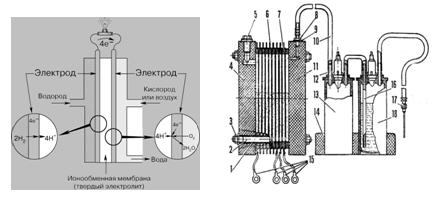
чл.-корр. РАН Иванчев С.С.
В соответствии с инициативой Международного союза теоретической и прикладной химии – ИЮПАК (IUPAC) Организация Объединённых Наций объявила 2011-й год Международным годом химии. Идею его проведения, выдвинутую представителями Национального комитета российских химиков, поддержали ряд стран и международное химическое сообщество.
Успехи фундаментальной химии в значительной мере определяют современный уровень понимания устройства материального мира, а химические технологии и процессы играют ключевую роль в решении глобальных проблем, таких как изменение климата, обеспечение населения планеты чистой водой, пищей и энергией, сохранение окружающей природной среды. Девиз Международного года химии “Химия – наша жизнь, наше будущее” подчёркивает важнейшую роль этой науки в обеспечении устойчивого развития человечества.
Одна из целей Международного года химии – способствовать пониманию роли химии различными слоями общества и повышению интереса к химическим наукам у молодёжи. Предполагается, что лекции, выставки, сопровождаемые демонстрацией химических экспериментов, позволят наглядно объяснить, насколько важны химические исследования для создания новых видов энергии, развития средств связи и транспорта, медицины, сельского хозяйства и пищевой промышленности. Проведение Года химии даст возможность расширить международное сотрудничество химиков и их организаций, привлечь студентов и молодёжь к участию в научных конкурсах, встречах и конференциях, пробудить интерес к изучению химии у школьников.
В рамках Года химии будет отпразднован ряд юбилеев. В 2011 г. исполняется 100 лет первому международному объединению химиков. Будет отмечаться 100-летие со времени присуждения Марии Кюри Нобелевской премии по химии за открытие и исследование радия и полония, что даст повод рассмотреть роль женщин в науке. Исполняется 300 лет со дня рождения М.В. Ломоносова, внесшего выдающийся вклад в становление и развитие химической науки в России.
Официальное открытие Международного года химии состоялось 27 января 2011 г. в штаб-квартире ЮНЕСКО (Париж, Франция).
15 февраля в Большом зале Российской академии наук прошла Торжественная церемония открытия Международного года химии в Москве. Торжественную церемонию открыл вице-президент РАН, академик Сергей Алдошин докладом “Высокий уровень фундаментальных химических исследований в России”. Академик С. Алдошин зачитал приветствие от президента РФ Дмитрия Медведева участникам церемонии, в котором говорилось: “Для нашей страны проведение акций года имеет большое значение. Они призваны привлечь внимание общества к этому важнейшему направлению научно-производственной деятельности”.
С приветствием к участникам съезда также выступил глава Минобрнауки Андрей Фурсенко. Он отметил, что химия как наука всегда высоко ценилась в России. Министр также сказал, что в настоящее время изучение многих наук сдвигается в сторону умозрительных абстрактных дисциплин, которые изучаются с помощью компьютера. “Химию через компьютер изучить нельзя, нужно что-то взорвать, почувствовать”, — отметил Фурсенко, — “успехи российских школьников на олимпиадах по химии показывают, что Россия все еще остается лидером в этой науке”.
На церемонии также выступила президент Международного союза чистой и прикладной химии (ИЮПАК) Николь Маро. По ее словам, если научное сообщество хочет привлечь внимание публики к своей науке, ему нельзя ограничиваться планами только на год, необходимо и дальше заниматься популяризацией своей дисциплины. Год химии учрежден по инициативе Международного союза теоретической и прикладной химии (International Union of Pure and Applied Chemistry, IUPAC), и в 2008 году ООН поручила этой организации и ЮНЕСКО провести соответствующие меро-приятия. Основной своей задачей организаторы считают привлечение внимания общественности к роли химии в обеспечении устойчивого развития человечества.
Председатель Совета Федерации ФС РФ С.М. Миронов приветствовал собравшихся. Он отметил, что Год химии нужен не столько химикам, столько всему обществу. “Думаю, что при всей важности этого года для ученых, студентов, аспирантов, технологов, для всех, кто так или иначе связан с химической наукой, этот Год достигнет в нашей стране своих целей, если его мероприятия выйдут за рамки “химического” сообщества. Людям, которые всерьез занимаются наукой, по большому счету ведь все равно, что там написано в календаре. Они будут делать любимое дело и в Год химии, и в любой другой. Но очень важно напомнить обществу и государству, насколько их благополучие и процветание зависят от состояния науки. От того, в каких условиях работают ученые, от того, насколько их находки востребованы экономикой. И если Год химии станет таким напоминанием, если он поможет сделать еще одни шаг в осознании неразрывной связи между со-стоянием науки и состоянием общества, то он будет проведен не зря”, — сказал С.М. Миронов.
Открытие Международного года химии приветствовали также академики М. Тартаковский, В. Садовничий, В. Лунин, председатель РФФИ В. Панченко и другие.
С научными докладами на тему “Химия – наша жизнь” выступили: член-корр. Н.П. Тарасова – “Мария Кюри – нить судьбы”, академик В.В. Лунин – “Проблемы подготовки кадров для химического образования и науки в России”,
Источник: http://www.ras.ru
д.т.н. А.С. Носков
5-9 сентября 2010 года в столице Австрии Вене прошла XIX Международная конференция по химическим реакторам ХИМРЕАКТОР-19. Конференция была включена в план мероприятий Европейской Федерации по химическим технологиям. Основным организатором конференции традиционно стал Институт катализа им. Г.К. Борескова Сибирского отделения РАН. Соорганизаторами выступили Российский центр науки и культуры в Вене, Федеральное агентство “Россотрудничество”, Министерство образования и науки Российской Федерации, Научный совет по теоретическим основам химической технологии РАН и Научный совет по катализу РАН.
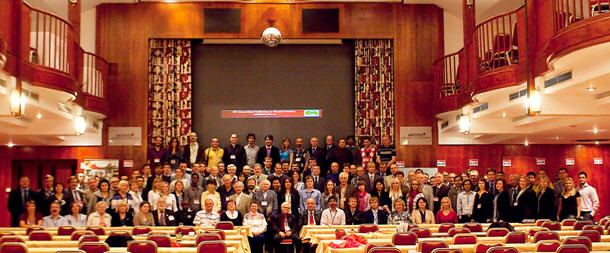
Серия конференций ХИМРЕАКТОР имеет глубокие традиции, восходящие к Всесоюзным совещаниям по моделированию химических реакторов, проходившим в 60-е годы прошлого столетия, сейчас она проводится каждые два года в крупных научных, производственных и культурных центрах мира. Выбор места проведения XIX Международной конференции по химическим реакторам пал на ослепительную европейскую столицу — город Вену.
В настоящее время каталитические процессы и реакторы являются базовыми для химического и нефтехимического секторов экономики, они также создают основу экологически безопасных технологий в других отраслях, способствуют развитию химических методов квалифицированного использования возобновляемого природного сырья. В Вене конференция ХИМРЕАКТОР-19 собрала более 200 известных в мире специалистов, половину из них составляли представители российской науки и производства, иностранные участники конференции приехали из 37 стран мира. Научная программа конференции включала 6 пленарных и 7 ключевых лекций, 70 устных и 100 стендовых докладов.
На предыдущей конференции ХИМРЕАКТОР-18, которая проходила на Мальте, было решено учредить научную лекцию имени профессора М.Г. Слинько, который был основателем конференции, бессменным ее руководителем до 2003 года и почетным Председателем до 2008 года. Право чтения лекции будет предоcтавляться известным ученым, достигшим крупных результатов в области математического моделирования химических процессов и реакторов. Первую Слиньковскую лекцию, открывшую конференцию ХИМРЕАКТОР-19, представил один из учеников М.Г. Слинько, профессор Ю. Матрос (компания Matros Technologies, США). Лекция на актуальную во все времена тему “Как разработать оптимальный каталитический реактор” еще раз подтвердила богатство творческого наследия и роль научной школы, созданной М.Г. Слинько. Кроме освещения научной биографии М.Г. Слинько, лектор продемонстрировал эволюцию методов математического моделирования с 60-х годов до настоящего времени, отразил состояние современных исследований по развитию идей М.Г. Слинько в области математического моделирования каталитических процессов, проблем нелинейной динамики каталитических процессов и реакторов. Показан сложный, многоуровневый и мультидисциплинарный характер задачи создания оптимальных реакторов, проанализированы основные достижения и некоторые причины неудач на этом пути.
Пленарные лекции носили обзорный характер и отразили ключевые направления, которые легли в основу научной проблематики конференции. Директор Института мембранных технологий из Италии, профессор Л. Джиорно, осветила в своей лекции состояние разработок мембранных реакторов, перспективы их использования в сепарации газов, при переработке сточных вод, в пищевой промышленности и медицине. Мембранные биореакторы и основанные на них биотехнологии особенно привлекательны с экологической точки зрения. Кроме того, применение мембранных реакторов хорошо вписывается в общую идеологию концепции устойчивого развития.
В области создания новых перспективных типов химических реакторов особый интерес представляют многофункциональные устройства. Именно этому вопросу была посвящена лекция профессора Я. Схаутена (Эйндховенский технологический университет, Нидерланды). Он начал с краткого экскурса в историю создания многофункциональных микрореакторов и проследил связь между микрореакторами и контактными устройствами с набором вращающихся дисков. Благодаря хорошему перемешиванию газовой смеси, в таких устройствах достигаются высокие коэффициенты тепло- и массообмена, что позволяет резко увеличить производительность и селективность катализатора по сравнению с традиционными реакторами.
В лекции доктора Х. Ститта (фирма Johnson Matthey, Великобритания) были высказаны интересные идеи проведения многофазных каталитических процессов в реакторах, структурированных в масштабе 0.5-5 мм. Микроканальные и монолитные системы такого типа позволяют улучшить смешение, интенсифицировать перенос тепла и массы, что позволит преодолеть снижение производительности реакторов с мешалками при масштабном переходе. Лектор привлек внимание к проблемам поиска новых областей применения структурированных многофазных реакторов, в которых их уникальные свойства могут проявиться наиболее ярко.
Директор Института проблем переработки углеводородов СО РАН, член-корреспондент РАН В. Лихолобов (Омск, Россия) показал, что различные формы наноструктурированных углеродных материалов, таких как фуллерены, луковичные структуры, нанотрубки, нанонити, графены и др. могут стать основой для индустрии наноматериалов. В своей пленарной лекции он изложил технологические основы производства различных видов наноуглеродных материалов специального назначения из газообразных и жидких углеводородов через стадию формирования наноглобул. Обозначены перспективы их практического применения и новые направления в высокотемпературном синтезе наноструктурированных углеродных композитов.
Пленарная лекция доктора В. Яковлева (Институт катализа СО РАН, Россия) была посвящена основным тенденциям развития биоэнергетики с акцентом на получение моторных биотоплив. Основное внимание было уделено разработке катализаторов и процессов на их основе для получения биодизеля, грин-дизеля — топлива с высоким цетановым числом. Сопряженные процессы переэтерификации и мягкого гидрокрекинга позволяют комплексно перерабатывать в биотопливо различные растительные масла и другое растительное сырье. Лектор также показал возможности использования для получения биотоплив еще одного вида возобновляемого сырья — продуктов пиролиза древесины.
Участники конференции отметили, что пленарная сессия прошла на высоком научном уровне, авторами были представлены новейшие результаты по приоритетным направлениям развития химических технологий. Важную роль в формировании научных дискуссий по основным направлениям конференции сыграли ключевые доклады, как правило, они носили характер постановки задач и задавали тон секционным устным докладам.
Научная программа конференции ХИМРЕАКТОР-19 была представлена докладами в трех секциях и традиционно включала работы, посвященные кинетическим исследованиям, физико-химическим и математическим основам процессов в реакторах, а также изучению тепло-массопереноса и гидродинамики в химических реакторах.
Секция I была посвящена достижениям в области кинетических исследований и разработки научных основ создания химических реакторов.
В области фундаментальных аспектов значительное внимание было уделено разработкам новых перспективных типов химических реакторов. Среди этих разработок особый интерес представляют многофункциональные микрореакторы, которым была посвящена пленарная лекция профессора Я. Схаутена. Вопросам тепломассопереноса и моделированию аэродинамики течения газовой смеси в данных типах реакторов был посвящен ряд устных докладов: Р.Г. Джорди (фирма Sasol Technology, Южная Африка), Е. Реброва (Эйндховенский технологический университет, Нидерланды).
В ключевой лекции М. Синева (Институт химической физики РАН, Москва) был проведен анализ развития за последние 30 лет кинетических исследований процесса получения углеводородов непосредственно из метана — так называемого окислительного сочетания метана. Отмечены этапы развития кинетических моделей, начиная с феноменологических подходов, заканчивая детальными исследованиями механизма реакции на основе применения современных физико-химических методов. Результаты моделирования данного процесса в реакторе с псевдоожиженным слоем катализатора были представлены в устном докладе С.М. Джасо (Берлинский технологический институт, Германия). История разработки реакторов “реверс-флоу”, которые сочетают протекание химической реакции и регенерацию тепла в неподвижном слое катализатора, была рассмотрена в ключевой лекции Г. Бунимовича (фирма Matros Technologies, США). Основное внимание было уделено результатам их технологического использования в различных промышленных процессах.
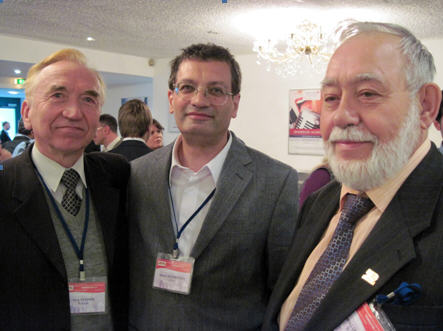
Применению методов компьютерного CFD-моделирования для исследования течения реагирующих сред в различных химических реакторах были посвящены доклады С. Антала (фирма Interphase Dynamics, США — процесс получения жидких топлив методом “газ в жидкость”), Э. Эркоча (Дрезденский Технический университет, Германия — течение газожидкостных потоков в узких капиллярных каналах), О. Кленова (Институт катализа СО РАН, Новосибирск — гидродинамика трехфазных реакторов с суспендированным катализатором).
Всего в рамках этой секции было прочитано 26 докладов, затрагивающих разные каталитические реакции, от риформинга метана на перовскитных катализаторах (В. Садыков, Институт катализа СО РАН, Новосибирск), окисления циклогексена (О. Темкин, Московская Академия тонкой химической технологии), о-ксилола (Ф. Лопес-Изунза, Университет Мехико) до, например, получения камфена из α-пинена — продукта, который применяют для производства душистых веществ и синтетической камфары (И. Симакова, Институт катализа СО РАН, Новосибирск).
Разработка новых реакторов, моделирование физико-химических процессов в реакторах, а также оптимизация режимов их работы с целью улучшения эксплуатационных показателей были широко представлены на Секции II, в рамках этой секции было сделано 24 устных доклада. Семь из них были посвящены использованию структурированных реакторов, включая уже традиционно популярные микрореакторы, для увеличения селективности и производительности каталитических процессов и обеспечения безопасности их проведения. В частности, в докладах рассматривались сильно экзотермические процессы производства водорода методом парциального окисления углеводородов, процесс селективного окисления СО в присутствии водорода, процессы гидрирования.
Большой интерес вызвал доклад профессора Д. Ласса (Хьюстонский университет, США), посвященный регенерации противосажевых фильтров дизельных двигателей закрытого типа. Представлены экспериментальные результаты определения оптимальных условий регенерации фильтров, обеспечивающих высокую скорость и полноту химических реакций дожигания частиц сажи, а также сохранность микроканалов фильтра от спекания.
В докладах П. Снытникова и М. Зыряновой (Институт катализа СО РАН, Новосибирск) были представлены результаты исследований в микроканальных реакторах процесса селективного окисления СО в присутствии водорода на медь-цериевом катализаторе и метанирования СО на никель-цериевом катализаторе.
Использованию мембранных технологий для увеличения производительности химических процессов за счет сдвига химического равновесия в сторону образования полезных продуктов были посвящены три доклада. Так, А. Кучеров (Институт органической химии РАН, Москва) продемонстрировал высокопроизводительный и безопасный способ получения этилена путем окислительного дегидрирования этана в мембранном реакторе.
Несколько работ были посвящены изучению возможностей применения гидродинамических эффектов (создание струй, вихревые эффекты) для интенсификации процессов тепло- и массопереноса с целью использования при разработке химических аппаратов. Два доклада касались преимуществ использования микроволнового излучения в качестве источника энергии для проведения таких эндотермических каталитических процессов, как производство водорода методом паровой конверсии метанола и каталитический пиролиз тяжелых углеводородов.
В девяти представленных докладах основным инструментом исследования являлось математическое моделирование физико-химических процессов в реакторах различных типов, включая реакторы для многофазных процессов, реакторы с неподвижным и с кипящим слоем катализатора, структурированные, мембранные и многофункциональные реакторы. В докладе С. Тхотла (Институт им. Макса Планка, Германия) обсуждены пути повышения эффективности процессов ректификации за счет оптимизации конструкции реактора. В докладе И. Агирре (Университет Бильбао, Испания) показаны преимущества технологии каталитической дистилляции для получения ацеталя. Каталитическая дистилляция является новой, передовой технологией проведения процессов, в которой сочетаются катализ и разделение продуктов реакции и исходных веществ.
В нескольких работах было продемонстрировано успешное использование методов математического моделирования для оптимизации промышленных каталитических процессов синтеза окиси этилена (С. Чжу, Восточно-Китайский университет, Шанхай, Китай), парциального окисления о-ксилола (С. Кастильо-Араиза, Университет Истапалапа, Мексика), синтеза никотиновой кислоты (Е. Овчинникова, Институт катализа СО РАН, Новосибирск).
Как обычно, большим вниманием пользовалась предметная область, связанная с вопросами производства и использования альтернативных топлив. Направление, посвященное процессам переработки биомассы в продукты топливного и химического назначения, было представлено в рамках отдельной подсекции А секции III и отражено в 18 устных и 15 стендовых докладах. В своей ключевой лекции профессор В. Кафаров (Колумбийский нефтехимический институт) представил интересные результаты получения биотоплив третьего поколения из микроводорослей с высоким содержанием липидов, это направление является одним из самых популярных в биоэнергетике. Ключевая лекция профессора K. Ван Гима (Гентский университет, Бельгия) была посвящена получению олефинов через каталитический крекинг тяжелых фракций продуктов пиролиза биомассы. Следует отметить ряд работ сотрудников университета Abo Akademi из г. Турку, Финляндия, в котором под руководством профессора Д.Ю. Мурзина ведутся исследования в области переработки растительного сырья с получением ценных химических соединений. Профессор Э. Хеерес (Гронингенский университет, Нидерланды) изложил актуальный подход к фракционированию бионефти, продукта быстрого пиролиза биомассы, с целью выделения ценных водорастворимых химических соединений типа карбоновых кислот, альдегидов, фенолов, фуранов и левоглюкозана. Такой комплексный подход обеспечивает более полное использование продуктов пиролиза биомассы, в результате чего может быть повышена конкурентоспособность пиролизных технологий. В целом содержание докладов в очередной раз подчеркнуло важность использования современных подходов в катализе и инжиниринге при переработке возобновляемой растительной биомассы и создании каталитических процессов получения биотоплив.
Научные доклады подсекции В секции III были посвящены вопросам технологий защиты окружающей среды при переработке твердых отходов (2 доклада), производства водорода и экологически чистых топлив (5 докладов), переработки природного газа и нефти (3 доклада), переработки биоэтанола в ценные продукты (2 доклада). В частности, в докладе М. Сугано (Университет Нихон, Япония) рассмотрен процесс термической переработки автомобильных покрышек путем их ожижения совместно с углем. Производство водорода из биомассы обсуждалось в докладах профессора И. Ханика (Институт теоретических основ химических процессов, Прага, Чешская Республика), С. Эрнандеса (Туринский институт технологии, Италия). Технология получения из биоэтанола моторных топлив с низким содержанием ароматических веществ рассмотрена в докладе Ю. Макарфи (Московская академия тонкой химической технологии, Россия), а в докладе А. Кагырмановой (Институт катализа СО РАН, Новосибирск) приведены результаты испытания процесса получения этилена из биоэтанола. Моделирование и экспериментальные результаты процесса экологически чистого каталитического сжигания природного газа в энергетических газотурбинных установках представлены в докладе профессора З. Исмагилова (Институт катализа СО РАН, Новосибирск).
По традиции в рамках конференции были организованы выставка химического оборудования и презентации фирм. Большой интерес вызвала экспозиция компании UOP (США), являющейся лидером передовых технологий для нефтеперерабатывающей, газоперерабатывающей и нефтехимической отраслей. Компания Peter Huber (Германия) представила результаты практического использования термостатов. Компании LAAKS (Россия) и ООО “Ростбиохим” (Россия), Autoclave Engineers Division of Snap-Tite Inc. (США) представили лабораторное оборудование для каталитических исследований при высоких давлениях, в частности, реактор для процесса Фишера-Тропша и других высокотемпературных процессов. Привлекли внимание экспонаты компании Tirit (Швейцария), одного из крупнейших поставщиков реакторных систем высокого давления. В выставке принял участие г-н Пол Петерс (США), директор Европейского представительства международной информационной службы Chemical Abstracts Service. Рекламно-информационные продукты компании вызвали большой интерес у делегатов конференции. Обсуждение представленных экспонатов продолжалось на Круглых столах, организованных представителями компаний.
Конференция ХИМРЕАКТОР-19 отразила прогресс, достигнутый в мировой науке и промышленной практике в области разработки и исследования химических реакционных процессов за последние годы. Ее проведение позволило участникам обменяться ценной научной информацией, установить контакты для будущего сотрудничества, а также сформулировать наиболее актуальные направления будущих перспективных разработок и исследований. Сочетание работ глубокого фундаментального характера с докладами, имеющими важное практическое значение, стало отличительной чертой прошедшего научного форума.
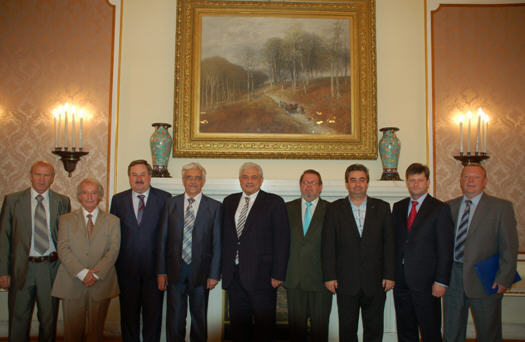
Большую поддержку в проведении конференции оказали Посольство Российской Федерации в Австрийской Республике и Российский центр науки и культуры (РЦНК) в Вене. Их деятельное участие обеспечило оперативное решение многих вопросов в подготовительный период и способствовало четкой организации мероприятия международного уровня. На открытии в адрес конференции поступило поздравление от Чрезвычайного и Полномочного посла Российской Федерации в Австрийской Республике господина С.Ю. Нечаева, а в церемонии открытия участвовал директор РЦНК О.Ю. Ксенофонтов. Во время работы конференции в Посольстве России состоялась встреча Чрезвычайного и Полномочного посла РФ С.Ю. Нечаева с делегацией участников конференции. На встрече присутствовали ведущие российские ученые, представители бизнеса и зарубежные соотечественники. Стороны отметили высокий уровень организации конференции и подтвердили взаимную заинтересованность и готовность к дальнейшему расширению сотрудничества в научно-технической сфере. Посол С.Ю. Нечаев предложил сделать Вену местом регулярных конференций с участием австрийских и российских специалистов, а также общеевропейских и международных конгрессов по развитию инновационных технологий в наукоемких, высокотехнологичных отраслях.
Завершив конференцию ХИМРЕАКТОР-19 в Вене, инициативная группа разворачивает организационную работу по проведению очередной, на этот раз юбилейной, конференции ХИМРЕАКТОР-20, которая должна состояться в 2012 г.
В подготовке настоящего материала приняли участие В.А. Чумаченко,
С.И. Решетников, А.П. Кагырманова,
Е.И. Смирнов, В.А. Яковлев и Т.В. Замулина.
Главный редактор:
Н.С. Зефиров
академик РАН, Химический факультет Московского государственного университета, Москва, Россия
Подробная информация о журнале размещена на сайте издательства МАИК "Наука/Интерпериодика":
www.maik.ru/cgi-perl/journal.pl?lang=rus&name=surchem&page=main
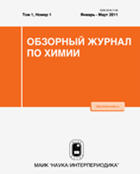 Международная академическая издательская компания “Наука/Интерпериодика” предлагает для ознакомления новое издание —
“ОБЗОРНЫЙ ЖУРНАЛ ПО ХИМИИ”. Журнал охватывает все аспекты современных исследований в области химии,
включая фундаментальные и прикладные аспекты органической, неорганической, элементоорганической, физической,
биологической, медицинской, теоретической и аналитической химии и теоретические аспекты химической технологии,
а также материалы в области междисциплинарных исследований, связанных с химией.
Международная академическая издательская компания “Наука/Интерпериодика” предлагает для ознакомления новое издание —
“ОБЗОРНЫЙ ЖУРНАЛ ПО ХИМИИ”. Журнал охватывает все аспекты современных исследований в области химии,
включая фундаментальные и прикладные аспекты органической, неорганической, элементоорганической, физической,
биологической, медицинской, теоретической и аналитической химии и теоретические аспекты химической технологии,
а также материалы в области междисциплинарных исследований, связанных с химией.
В журнале публикуются только исчерпывающие критические обзоры. Приглашение редколлегии написать обзорную статью необязательно.
Одновременно издается англоязычная версия журнала “Review Journal of Chemistry”, которая распространяется компанией Springer http://springerlink3.metapress.com/.
Последующие номера “Обзорного журнала по химии” будут выходить только в электронном формате и размещаться в течение 2011 года в открытом доступе на сайте www.elibrary.ru.
“Обзорный журнал по химии” приглашает к сотрудничеству авторов. Все статьи проходят рецензирование.
Новый журнал по катализу, издается с 2011 года Американским химическим обществом
На сегодняшний день открыт доступ к первому номеру журнала: http://pubs.acs.org/journal/accacs.
Сотрудники НЭИКОНа http://www.neicon.ru ведут переговоры о включении журнала в список доступных журналов ACS.
Editor-in-Chief: Christopher W. Jones
Georgia Institute of Technology
E-mail: cjones@chbe.gatech.edu
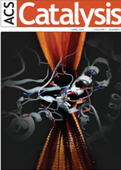 ACS Catalysis is dedicated to publishing original research on heterogeneous catalysis, homogeneous catalysis, and bio-catalysis. Application coverage includes life sciences, drug discovery & development, household products, polymer discovery & production, environmental protection and energy & fuels.
ACS Catalysis is dedicated to publishing original research on heterogeneous catalysis, homogeneous catalysis, and bio-catalysis. Application coverage includes life sciences, drug discovery & development, household products, polymer discovery & production, environmental protection and energy & fuels.
Specifically, the journal will include both experimental and theoretical research and reviews on molecules, macromolecules or materials that are catalytic in nature, that is, they exhibit catalytic turnover. The journal seeks to acquire content in the areas of new reactions and new approaches to synthesis involving known catalysts, discovery of or modification of new catalysts, novel mechanistic and investigatory studies on catalysis, practical enhancements of known processes, and conceptual advances.
ACS Catalysis accepts and publishes Letters, Articles, Perspectives, Reviews, and Viewpoints.
Новый мультидисциплинарный журнал, посвященный теоретическим и технологическим аспектам катализа, издается с 2011 года RSC Publishing (Royal Society of Chemistry)
До конца 2012 года предоставляется свободный доступ ко всем статьям, опубликованным в журнале:
http://pubs.rsc.org/en/Journals/JournalIssues/CY
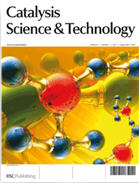 Editors-in-Chief:
Editors-in-Chief:
Professor Piet van Leeuwen
Professor Cynthia Friend
Catalysis Science & Technology is a new multidisciplinary journal that focuses on both the fundamental science and technological aspects of catalysis. The journal aims to contain a mix of fundamental, applied, experimental and computational work, thus appealing to both academic and industrial scientists. The journal brings together the top research from the homogeneous, heterogeneous and bio-catalysis communities. Catalysis Science & Technology will publish a full mix of primary articles, communications and reviews. Readership: academic and industrial chemists of all disciplines using heterogeneous and homogeneous catalysis: organic, organometallic, inorganic and bio(in)organic chemists; biochemists; physical and theoretical chemists; materials, polymer, surface, and environmental scientists. Free online access to all Catalysis Science & Technology content will be available until the end of 2012.
Готовится к печати первый выпуск нового международного журнала, освещающего все области органической химии. Издается Scientific Research Publishing (SRP www.scirp.org), USA http://www.scirp.org/journal/ijoc
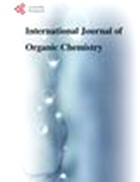 Editor-in-Chief: Prof. Bouzid Menaa, Fluorotronics Inc., USA
Editor-in-Chief: Prof. Bouzid Menaa, Fluorotronics Inc., USA
International Journal of Organic Chemistry (IJOC) is an international, specialized, English-language journal devoted to publication of original contributions concerning all field of organic chemistry.
It is an open-access, peer-reviewed journal describing the synthetic approached and the design of new molecules for applications in medicinal chemistry, but also for the synthesis of precursors for new materials (solid or liquid) that have an interest in materials sciences and nanotechnology, homogeneous and heterogeneous catalysis.
Contributions that concern with analytical characterization, advanced techniques and the studies of properties for new synthesized molecules will also be highlighted. All manuscripts must be prepared in English, and are subject to a rigorous and fair peer-review process. Accepted papers will immediately appear online followed by printed hard copy. The journal publishes original papers including but not limited to the following fields:
The journal publishes the highest quality original full articles, communications, notes, reviews, special issues and books, covering both the experimental and theoretical aspects of organic chemistry.
Papers are acceptable provided they report important findings, novel insights or useful techniques within the scope of the journal. All manuscript must be prepared in English, and are subjected to a rigorous and fair peer-review process. Accepted papers will immediately appear online followed by prints in hard copy.
Международный журнал, издается с 2010 года Göller Verlag под эгидой Немецкого керамического общества.
http://www.ceramic-science.com/
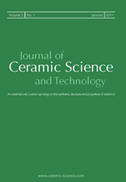 Journal Editor
Journal Editor
J.G. Heinrich
Clausthal University of Technology
Germany
The Journal of Ceramic Science and Technology publishes original scientific articles on all topics of ceramic science and technology from all ceramic branches. The papers may have either theoretical or experimental background. A high quality of publications will be guaranteed by a thorough reviewing process. The Journal is published by Göller Verlag on behalf of the German Ceramic Society.
MILLIONS OF ZEOLITE MATERIALS COMPUTED
Porous crystalline aluminosilicates known as zeolites are used in various applications for their catalytic, sorption, and ion-exchange properties. Nearly 200 distinct zeolite structures have been synthesized, and the target list got a whole lot larger: a computational team led by Michael W. Deem of Rice University has now calculated the structures of 2.7 million more seolite-like materials, at least 300,000 of which should be thermodynamically accessible as aluminosilicate compounds (J. Phys. Chem. C, DOI: 10.1021/jp906984z). In addition to the structures, Deem and colleagues calculated properties such as energy and density distributions, stability compared with quartz, dielectric constants, and X-ray diffraction patterns. The results are available in a publicly accessible database so researchers can either identify unknown zeolite products or search for targets with desired properties. All of the known zeolites have a relatively low density compared with the full range of calculated materials, Deem notes, adding that the computed structures offer new possibilities ranging from ultra-low density materials to high-density materials for nontraditional applications, such as corrosion-resistant coatings.
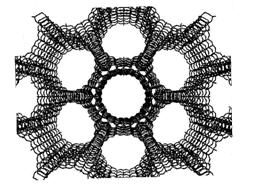
This computed zeolite structure has pores surrounded by rings of 24 silicon atoms, creating possible storage areas for macromolecules
WWW.CEN-ONLINE.ORG
OCTOBER 26, 20009
KEY METAL-METHANE COMPLEX OBSERVED
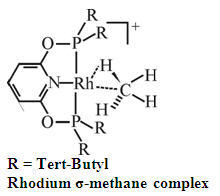 A transition-metal-methane complex believed to mimic a key intermediate in the conversion of natural gas into liquid fuels has finally been observed
(Science 2009, 326, 553). In the species, the electrons of a C–H bond serve as a donor ligand to the metal, an arrangement
called a σ complex. Such σ complexes are well-known for H2
and likely occur as intermediates in hydrogenation and hydrogenolysis reactions but have not been documented for methane in solution.
A research team led by Maurice Brookhart of the university of North Carolina, Chapel Hill, protonated a Rh–CH3 complex to
yield a stable Rh–CH
A transition-metal-methane complex believed to mimic a key intermediate in the conversion of natural gas into liquid fuels has finally been observed
(Science 2009, 326, 553). In the species, the electrons of a C–H bond serve as a donor ligand to the metal, an arrangement
called a σ complex. Such σ complexes are well-known for H2
and likely occur as intermediates in hydrogenation and hydrogenolysis reactions but have not been documented for methane in solution.
A research team led by Maurice Brookhart of the university of North Carolina, Chapel Hill, protonated a Rh–CH3 complex to
yield a stable Rh–CH![]() species. They characterized the complex by nuclear magnetic resonance spectroscopy
and found a sharp resonance for the methane and protons, indicating that they are in very rapid exchange. The species is isoelectronic with
a Pt(II) σ-methane complex that is believed to be an intermediate in Pt(II)-mediated methane oxidation reactions. The σ-methane complex “furnishes details about the
weak interaction of methane with a transition-metal center before C–H bond scission,” the authors write.
species. They characterized the complex by nuclear magnetic resonance spectroscopy
and found a sharp resonance for the methane and protons, indicating that they are in very rapid exchange. The species is isoelectronic with
a Pt(II) σ-methane complex that is believed to be an intermediate in Pt(II)-mediated methane oxidation reactions. The σ-methane complex “furnishes details about the
weak interaction of methane with a transition-metal center before C–H bond scission,” the authors write.
WWW.CEN-ONLINE.ORG
OCTOBER 26, 20009
НАИБОЛЕЕ ЯРКИЕ СТАТЬИ
The discovery and validation of colorectal cancer biomarkers
Biomedical Chromatography
Ching-Seng Ang, Jason Phung, Edouard C. Nice
Lipidomics era: Accomplishments and challenges
Mass Spectrometry Reviews
Maroun Bou Khalil et al
MassBank: a public repository for sharing mass spectral data for life sciences
Journal of Mass Spectrometry
Hisayuki Horai et al
Upconversion: road to El Dorado of the fluorescence world
Luminescence
Li Ching Ong, Muthu Kumara Gnanasammandhan, Sounderya Nagarajan, Yong Zhang
Drug metabolism in the horse: a review
Drug Testing and Analysis
James P. Scarth, Phil Teale, Tiia Kuuranne
Recent advances in linear and nonlinear Raman spectroscopy. Part IV
Journal of Raman Spectroscopy
Laurence A Nafie
Sample preparation for plant metabolomics
Phytochemical Analysis
Hye Kyong Kim, Rob Verpoorte
Multimodality imaging techniques
Contrast Media & Molecular Imaging
Luis Martí-Bonmatí, Ramón Sopena, Paula Bartumeus, Pablo Sopena
The evolution of partial least squares models and related chemometric approaches in metabonomics and metabolic phenotyping
Journal of Chemometrics
Judith M. Fonville et al
First-principles calculation of parameters of electron paramagnetic resonance spectroscopy in solids
Magnetic Resonance in Chemistry
Eugene S. Kadantsev, Tom Ziegler
Twenty five pitfalls in the analysis of diffusion MRI data
NMR in Biomedicine
Derek K. Jones, Mara Cercignani
Effect of mobile phase pH, aqueous organic ratio, and buffer concentration on electrospray ionization tandem mass spectrometric fragmentation patterns: implications in liquid chromatography/tandem mass spectrometric bioanalysis
Rapid Communications in Mass Spectrometry
Jian Wang et al
Special Issue: European Conference on X-Ray Spectrometry, 20–25 June 2010, Figueira da Foz,
Coimbra, Portugal
X-Ray Spectrometry
Review article: FRET microscopy: from principle to routine technology in cell biology
Journal of Microscopy
A. Pietraszewska-Bogiel, T.W.J. Gadella
Quick Screening of Crystal Methamphetamine/Methyl Sulfone Exhibits by Raman Spectroscopy
Journal of Forensic Sciences
Robert G. Weston
Electroanalytical Applications of Metallic Nanoparticles and Supramolecular Nanostructures
Electroanalysis
Itamar Willner, Bilha Willner, Ran Tel-Vered
Ionic liquid stationary phases for gas chromatography
Journal of Separation Science
Colin F. Poole and Salwa K. Poole
Recent advances in the MS analysis of glycoproteins: Theoretical considerations
ELECTROPHORESIS
Iulia M. Lazar, Alexandru C. Lazar, Diego F. Cortes, Jarod L. Kabulski
Targeted large-scale analysis of protein acetylation
PROTEOMICS
Nikolai Mischerikow and Albert J. R. Heck
CE-MS in biomarker discovery, validation, and clinical application
PROTEOMICS: Clinical Applications
Harald Mischak and Joost P. Schanstra
Optical Probes of Charge Generation and Recombination in Bulk Heterojunction
Organic Solar Cells
Macromolecular Chemistry and Physics
Ian A. Howard, Frédéric Laquai
π -Conjugated Donor and Donor–Acceptor Metallo-Polymers
Macromolecular Rapid Communications
Andreas Wild, Florian Schlütter, Georges M. Pavlov , Christian Friebe,
Grit Festag, Andreas Winter, Martin D. Hager, Vera Cimrová,
Ulrich S. Schubert
Injectable Biodegradable Hydrogels
Macromolecular Bioscience
Minh Khanh Nguyen, Doo Sung Le
Extrusion Processing and Properties of Protein-Based Thermoplastics
Macromolecular Materials and Engineering
Casparus J. R. Verbeek, Lisa E. van den Berg
Development of Entanglements in a Fully Disentangled Polymer Melt
Macromolecular Theory and Simulations
Thomas Vettorel, Kurt Kremer
Controlled Radical Polymerization: Industrial Stakes, Obstacles and Achievements
Macromolecular Reaction Engineering
Mathias Destarac
Fabrication, Assembly, and Application of Patchy Particles
Macromolecular Rapid Communications
Amar B. Pawar, Ilona Kretzschmar
Biomimetic Principles in Polymer and Material Science
Macromolecular Chemistry and Physics
Markus Antonietti, Peter Fratzl
ChemPhysChem
Direct Evidence of Coexisting Horseshoe and Extended Helix Conformations of
Membrane-Bound Alpha-Synuclein
Marta Robotta, Patrick Braun, Bart van Rooijen, Vinod Subramaniam,
Martina Huber, Malte Drescher
DNA Molecular Solvation in Neat Ionic Liquids
Lena Cardoso, Nuno M. Micaelo
Thermodynamic Methods and Models to Study Flexible Metal–Organic Frameworks
François-Xavier Coudert, Anne Boutin, Marie Jeffroy, Caroline Mellot-Draznieks, Alain H. Fuchs
Selective Pulsed Heating for the Synthesis of Semiconductor and Metal Submicrometer
Spheres
Hani Amouri, Jamal Moussa, Anna K. Renfrew, Paul J. Dyson,
Marie Noelle Rager and Lise-Marie Chamoreau
Theoretical Messenger Spectroscopy of Microsolvated Hydronium and Zundel Cations
Marcel Baer, Dominik Marx and Gerald Mathias
Direct Evidence of a Surface Quenching Effect on Size-Dependent Luminescence of Upconversion Nanoparticles
Xiaogang Liu
Chemistry – A European Journal
Unexpected Deformations Induced by Surface Interaction and Chiral Self-Assembly of
CoII-Tetraphenylporphyrin (Co-TPP) Adsorbed on Cu(110): A Combined STM and Periodic DFT Study
Philip Donovan, Abel Robin, Matthew S. Dyer, Mats Persson, Rasmita Raval
Kinetic Isotope Effects in Asymmetric Reactions
Thomas Giagou and Matthew P. Meyer
Nanographite Impurities Dominate
Electrochemistry of Carbon Nanotubesa
Adriano Ambrosi, Martin Pumera
Chemistry – An Asian Journal
Sugar-Decorated Dendritic Nanocarriers: Encapsulation and Release of the Octahedral Rhenium
Cluster Complex [Re6S8(OH)6]4-
Manja Kubeil, Holger Stephan, Hans-Jürgen Pietzsch, Gerhard Geipel, Dietmar Appelhans, Brigitte Voit, Jan Hoffmann, Bernhard Brutschy, Yuri V. Mironov, Konstantin
A. Brylev, Vladimir E. Fedorov
Light-Switchable Janus [2]Rotaxanes Based on α-Cyclodextrin Derivatives Bearing Two
Recognition Sites Linked with Oligo(ethylene glycol)
Shujing Li, Daisuke Taura, Akihito Hashidzume, Akira Harada
Electroanalysis
A Comparative Study of Electrochemical Reduction of 4-Nitrophenyl Covalently Grafted on
Gold and Carbon
Alicia L. Gui, Guozhen Liu, Muthukumar Chockalingam, Guillaume Le Saux, Erwann Luais, Jason B. Harper, J. Justin Gooding
Textile-based Electrochemical Sensing: Effect of Fabric Substrate and Detection of Nitroaromatic
Explosives
Min-Chieh Chuang, Joshua Ray Windmiller, Padmanabhan Santhosh, Gabriela Valdés Ramírez, Michal Galik, Tzu-Yang Chou, Joseph Wang
Additive Differential Pulse Voltammetry for the Study of Slow Charge Transfer Processes
at Spherical Electrodes
Eduardo Laborda, Emma I. Rogers, Francisco Martínez-Ortiz, Ángela Molina, Richard G. Compton
Surface and Interface Analysis
Effect of heat treatment on the properties and structure of TiO2 nanotubes: phase
composition and chemical composition
D. Regonini, A. Jaroenworaluck, R. Stevens, C.R. Bowen
A facial approach to fabricate superhydrophobic aluminum surface
Zhijun Chen, Yabing Guo, Shaoming Fang
Journal of Physical Organic Chemistry
Effect of substituent groups of porphyrins on the electroluminescent properties of porphyrin-doped
OLED devices
Lin-Jian Zhu, Jian Wang, Tie-Gang Reng, Chun-Yan Li, Dong-Cai Guo, Can-Cheng Guo
Forever young: polycyclic aromatic hydrocarbons as model
cases for structural and optical studies
R. Rieger, K. Müllen
ChemSusChem
Environmental Implications of the Surfactant Effect on the Photochemistry
of (Substituted) 4-Chlorophenols in Water
Veronica Canevari, Maurizio Fagnoni, Pietro Bortolus and Angelo Albini
Nanosizing and Nanoconfinement: New Strategies Towards Meeting Hydrogen
Storage Goals
Petra E. de Jongh and Philipp Adelhelm
Differentiation of Bulk and Surface Contribution to Supercapacitance in Amorphous and
Crystalline NiO
Qi Lu, Zachary J. Mellinger, Weigang Wang, Wanfeng Li, Yunpeng Chen, Jiangguang G. Chen and John Q. Xiao
Macromolecular Chemistry and Physics
Electrochemical Surface Plasmon Resonance and Field-Enhanced Light Scattering: Monomer
Copolymerization with a Polysiloxane-Conjugated Polythiophene Network Precursor
Akira Baba, Chuanjun Xia, Wolfgang Knoll, Rigoberto C. Advincula
Contemporary Mass Spectrometry and the Analysis of Synthetic Polymers: Trends,
Techniques and Untapped Potential
Gene Hart-Smith, Christopher Barner-Kowollik
Fuel Cells
Supercapacitors Technical Requirements for New Applications
M. Conte
Pseudocapacitance Effects for Enhancement of Capacitor Performance
G. Lota, E. Frackowiak
Propellants, Explosives, Pyrotechnics
Knudsen Effusion Measurement of Organic Peroxide Vapor Pressures
Paul L. Damour, Andrew Freedman, Joda Wormhoudt
Maxwell Fluid Model for Generation of Stress–Strain Curves of Viscoelastic Solid Rocket Propellants
H. Shekhar, A. D. Sahasrabudhe
Advanced Functional Materials
Synthesis of Magnetic, Up-Conversion Luminescent, and Mesoporous Core-Shell-Structured Nanocomposites as Drug Carriers
Shili Gai, Piaoping Yang, Chunxia Li, Wenxin Wang, Yunlu Dai, Na Niu,
Jun Lin
Solar Cells by Design: Photoelectrochemistry of TiO2 Nanorod Arrays Decorated with CdSe
Jin Ho Bang, Prashant V. Kamat
Chinese Journal of Chemistry
Effect of Combustion Improver on Combustion Behavior of Cigarette Paper by Simultaneous TG/DSC Detection
Huirong Li, Yi Liu, Dan Li, Bin Cai, Yikun Chen, Zhangang Cheng
Small
Fluorographene: A Two-Dimensional Counterpart of Teflon
Rahul R. Nair, Wencai Ren, Rashid Jalil, Ibtsam Riaz, Vasyl G. Kravets, Liam Britnell, Peter Blake, Fredrik Schedin, Alexander S. Mayorov, Shengjun Yuan, Mikhail I. Katsnelson, Hui-Ming Cheng,
Wlodek Strupinski, Lyubov G. Bulusheva, Alexander V. Okotrub, Irina V. Grigorieva, Alexander N. Grigorenko, Kostya S. Novoselov, Andre K. Geim
Mechanobiology: Correlation Between Mechanical Stability of Microcapsules Studied by AFM
and Impact of Cell-Induced Stresses
Mihaela Delcea, Stephan Schmidt, Raghavendra Palankar, Paulo Fernandes, Andreas Fery, Helmuth Möhwald, André Skirtach
Israel Journal of Chemistry
Electrochemistry of Single Nanoparticles via Electrocatalytic Amplification
Allen J. Bard, Hongjun Zhou, Seong Jung Kwon
Международная конференция
НАНОСТРУКТУРНЫЕ КАТАЛИЗАТОРЫ
И КАТАЛИТИЧЕСКИЕ ПРОЦЕССЫ
ДЛЯ ИННОВАЦИОННОЙ ЭНЕРГЕТИКИ
И УСТОЙЧИВОГО РАЗВИТИЯ
Проводится в рамках года Испании в России и года России в Испании
5-8 июня 2011 г., Академгородок, Новосибирск, Россия
http:/conf.nsc.ru/rsc/en
International conference
NANOSTRUCTURED CATALYSTS AND CATALYTIC
PROCESSES FOR THE INNOVATIVE ENERGETICS
AND SUSTAINABLE DEVELOPMENT
III Международная конференция
"ПРОИСХОЖДЕНИЯ И ЭВОЛЮЦИЯ БИОСФЕРЫ"
Крит, Греция, 16-20 октября 2011 г.
III International conference
BIOSPHERE ORIGIN AND EVOLUTION
Rithymno, Crete, Greece, October 16 - 20, 2011
http://conf.nsc.ru/BOE-2011/en/
|
20-22 апреля 2011 г. |
|
|
25-29 апреля 2011 г. |
|
|
May 8-11, 2011 |
|
|
May 18-20, 2011 |
|
|
June 1-3, 2011 |
|
|
5-8 июня 2011 г. |
В рамках года Испании |
|
June 5-8, 2011 |
|
|
June 5-8, 2011 |
|
|
June 6-10, 2011 |
|
|
6-11 июня 2011 г. |
|
|
June 20-23, 2011 |
|
|
June 20-24, 2011 |
|
|
21-24 июня 2011 г. |
|
|
June 26-30, 2011 |
|
|
June 27-30, 2011 |
|
|
June 27 - July 1, 2011 |
|
|
27 июня - 1 июля 2011 г. |
|
|
July 3-7, 2011 |
|
|
July 3-7, 2011 |
|
|
4-7 июля 2011 г. |
|
|
July 24-30, 2011 |
|
|
August 14-18, 2011 |
|
|
23-27 августа 2011 г. |
|
|
August 28 - September 1, 2011 |
|
|
August 28 - Sept 2, 2011 |
|
|
5-9 сентября 2011 г. |
|
|
September 11-18, 2011 |
|
|
13-16 сентября 2011 г. |
|
|
13-16 сентября 2011 г. |
|
|
September 13-16, 2011 |
|
|
September 25-29, 2011 |
|
|
25-30 сентября 2011 г. |
|
|
3-7 октября 2011 г. |
|
|
October 16-20, 2011 |
|
|
25-28 октября 2011 |
|
|
October 28-30, 2011 |
|
|
December 12-15, 2011 |
|
|
September 2-5, 2012 |


